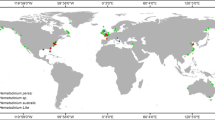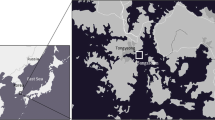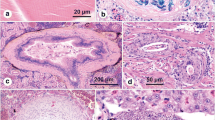Abstract
Hematodinium is a type of parasitic dinoflagellate that infects marine crustaceans globally. The parasite lives mainly in the hemolymph or hemocoels of affected hosts, and results in mortalities due to malfunction or loss of functions of major organs. In recent years, the parasite had developed into an emerging epidemic pathogen not only affecting wild populations of economically valuable marine crustaceans in western countries but also the sustainable yield of aquaculture of major crabs in China. The epidemics of the parasitic diseases expanded recently in the coastal waters of China, and caused frequent outbreaks in aquaculture of major crab species, especially Portunus trituberculatus and Scylla paramamosain. In addition, the pathogen infected two species of co-cultured shrimps and multiple cohabitating wild crabs, implying it is a significant threat to the sustainable culture of commercially valuable marine crustaceans. In particular, the polyculture system that is widely used along the coast of China may facilitate the spread and transmission of the pathogen. Thus, to provide a better understanding of the biological and ecological characteristics of the parasitic dinoflagellate and highlight important directions for future research, we have reviewed the current knowledge on the taxonomy, life cycle, pathogenesis, transmission and epidemiology of Hematodinium spp. Moreover, ecological countermeasures have been proposed for the prevention and control of the emerging infectious disease.








Similar content being viewed by others
References
Appleton PL, Vickerman K (1998) In vitro cultivation and developmental cycle in culture of a parasitic dinoflagellate (Hematodinium sp.) associated with mortality of the Norway lobster (Nephrops norvegicus) in British waters. Parasitology 116:115–130
Belachew EB (2018) Immune response and evasion mechanisms of Plasmodium falciparum parasites. J Immunol Res 2018:6529681
Briggs RP, McAliskey M (2002) The prevalence of Hematodinium in Nephrops norvegicus from the western Irish Sea. J Mar Biol Assoc UK 82:427–433
Cerenius L, Lee BL, Söderhäll K (2008) The proPO-system: pros and cons for its role in invertebrate immunity. Trends Immunol 29:263–271
Chatton E, Poisson R (1931) Sur l’existence, dans le sang des Crabes, de Péridiniens parasites: Hematodinium perezi n. g., n. sp. (Syndinidae). C R Seances Soc Biol 105:553–557
Davies CE, Batista FM, Malkin SH, Thomas JE, Bryan CC, Crocombe P, Coates CJ, Rowley AF (2019) Spatial and temporal disease dynamics of the parasite Hematodinium sp. in shore crabs Carcinus maenas. Parasite Vector 12:472
Eaton WD, Love DC, Botelho C, Meyers TR, Imamura K, Koeneman T (1991) Preliminary results on the seasonality and life cycle of the parasitic dinoflagellate causing bitter crab disease in Alaskan tanner crabs (Chionoecetes bairdi). J Invertebr Pathol 57:426–434
Field RH, Appleton PL (1995) A Hematodinium-like dinoflagellate infection of the Norway lobster Nephrops norvegicus: observations on pathology and progression of infection. Dis Aquat Organ 22:115–128
Field RH, Chapman CJ, Taylor AC, Neil DM, Vickerman K (1992) Infection of the Norway lobster Nephrops norvegicus by a Hematodinium-like species of dinoflagellate on the west coast of Scotland. Dis Aquat Organ 13:1–15
Field RH, Hills JM, Atkinson RJA, Magill S, Shanks AM (1998) Distribution and seasonal prevalence of Hematodinium sp. infection of the Norway lobster (Nephrops norvegicus) around the west coast of Scotland. ICES J Mar Sci 55:846–858
Fisheries Bureau of Agriculture Ministry of China (2017) China fishery statistical yearbook. China Agriculture Press, Beijing (in Chinese)
Guiry MD, Guiry GM (2020) Algae base. World-wide electronic publication, National University of Ireland, Galway https://www.algaebase.org. Accessed 21 July 2020
Hakimi MA, Cannella D (2011) Apicomplexan parasites and subversion of the host cell microRNA pathway. Trends Parasitol 27:481–486
Huang Q, Li M, Wang F, Li CW (2019) The parasitic dinoflagellate Hematodinium perezi infecting mudflat crabs, Helice tientsinensis, in polyculture system in China. J Invertebr Pathol 166:107229
Huchin-Mian JP, Small HJ, Shields JD (2017) Patterns in the natural transmission of the parasitic dinoflagellate Hematodinium perezi in American blue crabs, Callinectes sapidus from a highly endemic area. Mar Biol 164:153
Huchin-Mian JP, Small HJ, Shields JD (2018) The influence of temperature and salinity on mortality of recently recruited blue crabs, Callinectes sapidus, naturally infected with Hematodinium perezi (Dinoflagellata). J Invertebr Pathol 152:8–16
Hudson DA, Adlard RD (1996) Nucleotide sequence determination of the partial SSU rDNA gene and ITS1 region of Hematodinium cf. perezi and Hematodinium-like dinoflagellates. Dis Aquat Organ 24:55–60
Hudson DA, Shields JD (1994) Hematodinium australis n. sp., a parasitic dinoflagellate of the sand crab Portunus pelagicus from Moreton Bay. Australia Dis Aquat Organ 19:109–119
Li FH, Xiang JH (2013) Recent advances in researches on the innate immunity of shrimp in China. Dev Comp Immunol 39:11–26
Li CW, Xu WJ (2014) Review on parasitic dinoflagellates Hematodinium spp. in major marine crustaceans. Oceanol Limnol Sin 45:3–12
Li YY, Xia XA, Wu QY, Liu WH, Lin YS (2008) Infection with Hematodinium sp. in mud crabs Scylla serrata cultured in low salinity water in southern China. Dis Aquat Organ 82:145–150
Li CW, Shields JD, Miller TL, Small HJ, Pagenkopp KM, Reece KS (2010) Detection and quantification of the free-living stage of the parasitic dinoflagellate Hematodinium sp. in laboratory and environmental samples. Harmful Algae 9:515–521
Li CW, Miller TL, Small HJ, Shields JD (2011a) In vitro culture and developmental cycle of the parasitic dinoflagellate Hematodinium sp. from the blue crab Callinectes sapidus. Parasitology 138:1924–1934
Li CW, Wheeler KN, Shields JD (2011b) Lack of transmission of Hematodinium sp. in the blue crab Callinectes sapidus through cannibalism. Dis Aquat Organ 96:249–258
Li CW, Song SQ, Liu Y, Chen TT (2013) Hematodinium infections in cultured Chinese swimming crab, Portunus trituberculatus, in northern China. Aquaculture 396–399:59–65
Li M, Li C, Wang J, Song S (2015a) Immune response and gene expression in hemocytes of Portunus trituberculatus inoculated with the parasitic dinoflagellate Hematodinium. Mol Immunol 65:113–122
Li M, Li C, Wang J, Song S (2015b) Molecular characterization and expression of a novel Toll gene from the swimming crab Portunus trituberculatus. Mol Immunol 67:388–397
Li M, Wang J, Song S, Li C (2015c) Early transcriptional response to the parasitic dinoflagellate Hematodinium in hepatopancreas of Portunus trituberculatus. J Invertebr Pathol 130:28–36
Li M, Wang J, Song S, Li C (2016) Molecular characterization of a novel nitric oxide synthase gene from Portunus trituberculatus and the roles of NO/O2−-generating and antioxidant systems in host immune responses to Hematodinium. Fish Shellfish Immunol 52:263–277
Li M, Huang Q, Wang J, Li C (2018) Differential expression of microRNAs in Portunus trituberculatus in response to Hematodinium parasites. Fish Shellfish Immunol 83:134–139
Li M, Wang J, Huang Q, Li C (2019) Proteomic analysis reveals the immune responses of the hepatopancreas against Hematodinium infection in Portunus trituberculatus. J Proteomics 197:92–105
Love DC, Rice SD, Moles DA, Eaton WD (1993) Seasonal prevalence and intensity of Bitter Crab dinoflagellate infection and host mortality in Alaskan Tanner crabs Chionoecetes bairdi from Auke Bay, Alaska, USA. Dis Aquat Organ 15:1–7
Messick GA, Shields JD (2000) Epizootiology of the parasitic dinoflagellate Hematodinium sp. in the American blue crab Callinectes sapidus. Dis Aquat Organ 43:139–152
Messick GA, Sinderman CJ (1992) Synopsis of principal diseases of the blue crab, Callinectes sapidus. NOAA NMFS Tech Memo NMFS-F/NEC-88, Washington, D.C. p 24
Messick GA, Jordan SJ, Van Heukelem WF (1999) Salinity and temperature effects on Hematodinium sp. in the blue crab Callinectes sapidus. J Shellfish Res 18:657–662
Meyers TR, Koeneman TM, Botelho C, Short S (1987) Bitter crab disease: a fatal dinoflagellate infection and marketing problem for Alaskan Tanner crabs Chionoecetes bairdi. Dis Aquat Organ 3:195–216
Meyers TR, Botelho C, Koeneman TM, Short S, Imamura K (1990) Distribution of bitter crab dinoflagellate syndrome in southeast Alaskan tanner crabs, Chionoecetes bairdi. Dis Aquat Organ 9:37–43
Meyers TR, Morado JF, Sparks AK, Bishop GH, Pearson T, Urban D, Jackson D (1996) Distribution of bitter crab syndrome in Tanner crabs (Chionoecetes bairdi, C. opilio) from the Gulf of Alaska and the Bering Sea. Dis Aquat Organ 26:221–227
Morado JF, Siddeek MSM, Mullowney DR, Dawe EG (2012) Protistan parasites as mortality drivers in cold water crab fisheries. J Invertebr Pathol 110:201–210
Newman MW, Johnson CA (1975) A disease of blue crabs (Callinectes sapidus) caused by a parasitic dinoflagellate, Hematodinium sp. J Parasitol 63:554–557
Pagenkopp Lohan KM, Reece KS, Miller TL, Wheeler KN, Small HJ, Shields JD (2012) The role of alternate hosts in the ecology and life history of Hematodinium sp. a parasitic dinoflagellate of the blue crab (Callinectes sapidus). J Parasitol 98:73–84
Patrzia P, Giorgio M (2018) Parasites affect hemocyte functionality in the hemolymph of the invasive Atlantic blue crab Callinectes sapidus from a coastal habitat of the Salento Peninsula (SE Italy). Medit Mar Sci 19:193–200
Rico A, Satapornvanit K, Haque MM, Min J, Nguyen PT, Telfer TC, van den Brink PJ (2012) Use of chemicals and biological products in Asian aquaculture and their potential environmental risks: a critical review. Rev Aquac 4:75–93
Ringø E, Olsen RE, Vecino JLG, Wadsworth S, Song SK (2012) Use of immunostimulants and nucleotides in aquaculture: a review. J Mar Sci Res Dev 1:104
Ris H, Kublai DF (1974) An unusual mitotic mechanism in the parasitic protozoan Syndinium sp. J Cell Biol 60:702–720
Rowley AF, Smith AL, Davies CE (2015) How does the dinoflagellate parasite Hematodinium outsmart the immune system of its crustacean hosts? PLoS Pathog 11:e1004724
Sapkota A, Sapkota AR, Kucharski M, Burke J, McKenzie S, Walker P, Lawrence R (2008) Aquaculture practices and potential human health risks: current knowledge and future priorities. Environ Int 34:1215–1226
Sheppard M, Walker A, Frischer ME, Lee RF (2003) Histopathology and prevalence of the parasitic dinoflagellate Hematodinium sp, in crabs (Callinectes sapidus, Callinectes similis, Neopanope sayi, Libiniae marginata, Menippemer cenaria) from a Georgia estuary. J Shellfish Res 22:873–880
Shields JD (1994) The parasitic dinoflagellates of marine crustaceans. Annu Rev Fish Dis 4:241–271
Shields JD (2012) The impact of pathogens on exploited populations of decapod crustaceans. J Invertebr Pathol 110:211–224
Shields JD, Squyars CM (2000) Mortality and hematology of blue crabs, Callinectes sapidus, experimentally infected with the parasitic dinoflagellate Hematodinium perezi. Fish Bull 98:139–152
Shields JD, Scanlon C, Volety A (2003) Aspects of the pathophysiology of blue crabs, Callinectes sapidus, infected with the parasitic dinoflagellate Hematodinium perezi. B Mar Sci 72:519–535
Shields JD, Taylor DM, O’Keefe PG, Colbourne E, Hynick E (2007) Epidemiological determinants in outbreaks of bitter crab disease (Hematodinium sp.) in snow crabs, Chionoecetes opilio from Newfoundland. Canada Dis Aquat Organ 77:61–72
Shields JD, Huchin-Mian JP, O'Leary PA, Small HJ (2017) New insight into transmission dynamics of the crustacean pathogen Hematodinium perezi (Dinoflagellata) using a novel sentinel methodology. Mar Ecol Prog Ser 573:73–84
Small HJ (2012) Advances in our understanding of the global diversity and distribution of Hematodinium spp. – Significant pathogens of commercially exploited crustaceans. J Invertebr Pathol 110:234–246
Small HJ, Shields JD, Reece KS, Bateman K, Stentiford GD (2012) Morphological and molecular characterization of Hematodinium perezi (Dinophyceae: Syndiniales), a dinoflagellate parasite of the harbour crab, Liocarcinus depurator. J Eukaryot Microbiol 59:54–66
Stentiford GD, Shields JD (2005) A review of the parasitic dinoflagellates Hematodinium species and Hematodinium-like infections in marine crustaceans. Dis Aquat Organ 66:47–70
Stentiford GD, Chang ES, Chang SA, Neil DM (2001a) Carbohydrate dynamics and the crustacean hyperglycemic hormone (CHH): effects of parasitic infection in Norway lobsters (Nephrops norvegicus). Gen Comp Endocrinol 121:13–22
Stentiford GD, Neil DM, Atkinson RJA (2001b) The relationship of Hematodinium infection prevalence in a Scottish Nephrops norvegicus population to seasonality, moulting and sex. ICES J Mar Sci 58:814–823
Stentiford GD, Neil DM, Coombs GH (2001c) Development and application of an immunoassay diagnostic technique for studying Hematodinium infections in Nephrops norvegicus populations. Dis Aquat Organ 46:223–229
Taylor AC, Field RH, Parslow-Williams PJ (1996) The effects of Hematodinium sp.-infection on aspects of the respiratory physiology of the Norway lobster, Nephrops norvegicus (L.). J Exp Mar Bio Ecol 207:217–228
Wang RC, Yang JM, Zheng XD (2004) Current status of polyculture and rotation culture in Chinese mariculture industry. Acta Oceanol Sin 23:505–512 (in Chinese)
Wang J, Li C, Li M, Song S (2015) Morphology and histopathology of parasitic dinoflagellate Hematodinium sp. infecting Portunus trituberculatus. Oceano Limnol Sin 46:1–10 (in Chinese)
Wang JF, Li M, Xiao J, Xu WJ, Li CW (2017a) Hematodinium spp. infections in wild and cultured populations of marine crustaceans along the coast of China. Dis Aquat Organ 124:181–191
Wang W, Sun J, Liu C, Xue Z (2017b) Application of immunostimulants in aquaculture: current knowledge and future perspectives. Aquac Res 48:1–23
Wang YG, Yang Y, Zhang Z, Li B, Liao MJ, Deng W, Meng FL (2017c) Etiological and pathological analyses of massive mortality in cultured crab Portunus trituberculatus along the coasts of Tianjin and Hebei, China. J Fish Sci China 24:596–605 (in Chinese)
Wheeler KN, Shields JD, Taylor DM (2007) Pathology of Hematodinium infections in snow crabs (Chionoecetes opilio) from Newfoundland, Canada. J Invertebr Pathol 95:93–100
Wright GJ, Rayner JC (2014) Plasmodium falciparum erythrocyte invasion: combining function with immune evasion. PLoS Pathog 10:e1003943
Xiao J, Miao XX, Li CW, Xu WJ, Zhang XL, Wang ZL (2016) Genetic variations of the parasitic dinoflagellate Hematodinium infecting cultured marine crustaceans in China. Protist 167:597–609
Xu WJ, Sheng XZ, Xu HX, Shi H, Li PF (2007a) Dinoflagellates Hematodinium sp. parasitizing the mud crab Scylla serrata. Period Ocean Univ China 37:916–920 (in Chinese)
Xu WJ, Shi H, Xu HX, Small HJ (2007b) Preliminary study on the Hematodinium infection in cultured Portunus trituberculatus. Acta Hydrobiol Sin 31:637–642 (in Chinese)
Xu WJ, Xie JJ, Shi H, Li CW (2010) Hematodinium infections in cultured ridgetail white prawns, Exopalaemon carinicauda, in eastern China. Aquaculture 300:25–31
Yoshino TP, Wu XJ, Gonzale LA, Hooke CH (2013) Circulating Biomphalaria glabrata hemocyte subpopulations possess shared schistosome glycans and receptors capable of binding larval glycoconjugates. Exp Parasitol 133:28–36
Acknowledgements
This research was financially supported by the NSFC-Shandong Joint program (Grant No. U1906214) and the general program (Grant No. 41676102) of National Natural Science Foundations of China.
Author information
Authors and Affiliations
Contributions
CL wrote the original draft, ML and QH revised the manuscript. All authors reviewed and approved the final manuscript.
Corresponding author
Ethics declarations
Conflict of interest
The authors declare that they have no competing interests.
Animal and human rights statement
This article does not contain human participants or animals.
Additional information
Edited by Xin Yu.
Rights and permissions
About this article
Cite this article
Li, C., Li, M. & Huang, Q. The parasitic dinoflagellate Hematodinium infects marine crustaceans. Mar Life Sci Technol 3, 313–325 (2021). https://doi.org/10.1007/s42995-020-00061-z
Received:
Accepted:
Published:
Issue Date:
DOI: https://doi.org/10.1007/s42995-020-00061-z




